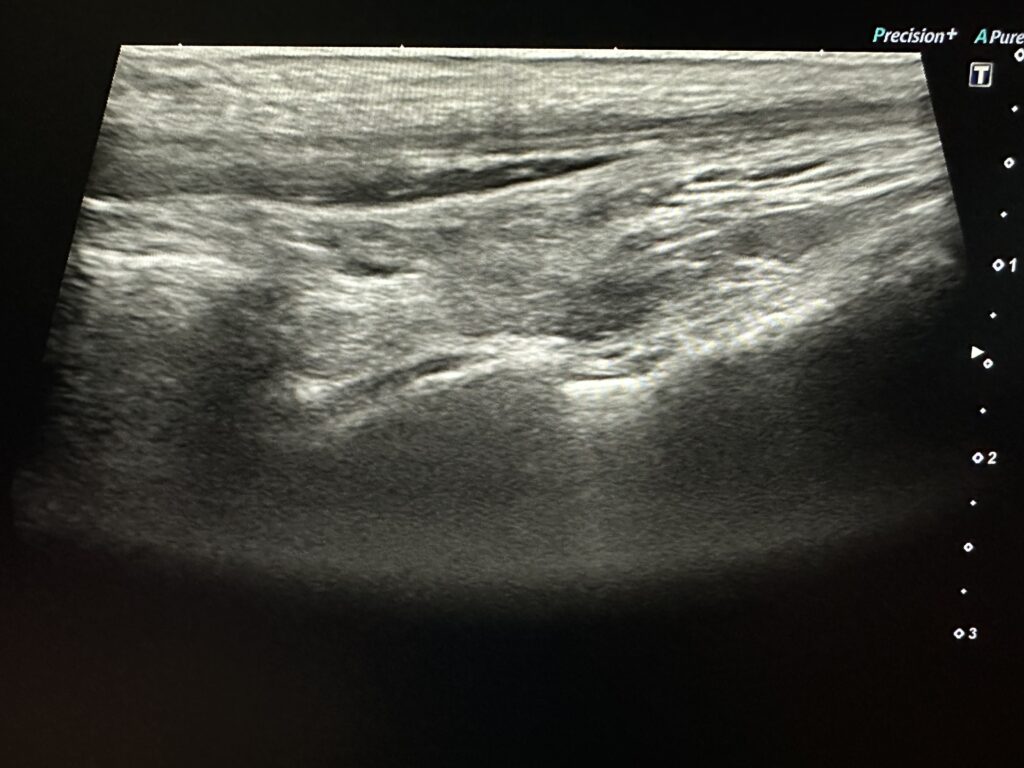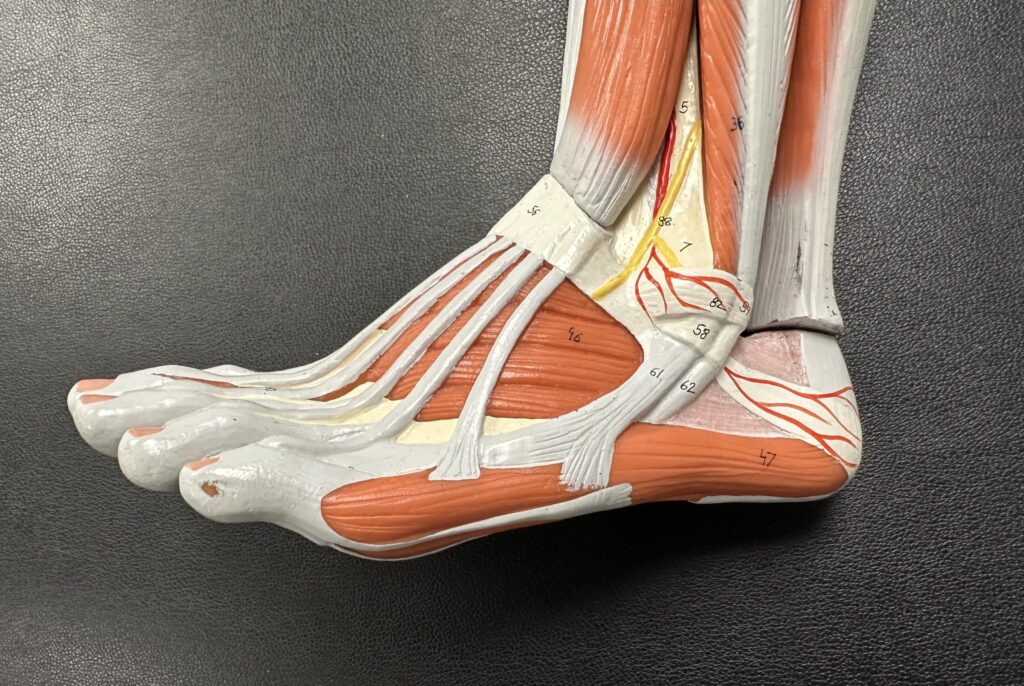Ankle impingement is a condition where tissues in the ankle get pinched, leading to pain and restricted movement. This article covers its symptoms, causes, and treatment options.
Key Takeaways
Ankle impingement involves entrapment of structures in the ankle joint leading to pain, limited range of motion, and significant functional limitations, particularly in athletes.
Treatment options include conservative methods such as rest and physical therapy, alongside surgical interventions like debridement when conservative measures fail.
Early recognition of symptoms and appropriate diagnosis through clinical examination and imaging techniques are crucial for effective management of ankle impingement.
Understanding Ankle Impingement
Ankle impingement refers to pain in the ankle caused by the entrapment of structures in either the anterior or posterior areas of the ankle joint. This condition is often associated with limited range of motion and pain during specific movements and load-bearing activities. Commonly seen in athletes and individuals with a history of ankle injuries, ankle impingement syndromes can significantly impact mobility and quality of life. These syndromes often result from post-traumatic and chronic degenerative changes that lead to ongoing discomfort and functional limitations.
Understanding the anatomy of the ankle joint and the different types of impingement provides a solid foundation for recognizing symptoms, identifying causes, and exploring effective treatment options.
Ankle Joint Anatomy
The ankle joint is a synovial hinge joint, primarily facilitating movement in one plane.
This joint is composed of:
The talus bone fitting into a bracket-like shape formed by the tibia and fibula
The medial and lateral ligament complexes that hold these bones together, ensuring stability and support during movement
The joint capsule and articular cartilage that play crucial roles in maintaining smooth motion and cushioning the joint against impact.
The anteromedial ankle recess, formed by the talus, anteromedial joint capsule, medial malleolus, and anterior tibiotalar ligament, is one of the critical areas where impingement can occur. Knowing the intricate structures of the ankle joint, such as the posterior talofibular ligament and the posterior intermalleolar ligament, helps in comprehending how different types of impingement develop and affect mobility.
Types of Ankle Impingement
Ankle impingement can be categorized into several types, each affecting different areas of the ankle joint. Anterior ankle impingement occurs when structures get trapped along the front edge of the tibiotalar joint. This usually happens during full dorsiflexion. Symptoms of anterior ankle impingement include pain and limited range of motion at the front of the ankle.
Posterior ankle impingement syndrome involves the compression of structures located behind the tibiotalar and talocalcaneal joints. This typically occurs during terminal plantar flexion. Other types, such as anterolateral impingement, often occur due to obstruction of the anterolateral gutter, leading to localized pain and limited dorsiflexion.
Posteromedial impingement involves structures in the posteromedial recess, bordered by the medial malleolus and posterior joint capsule. Identifying these various types aids in pinpointing specific symptoms and tailoring treatment approaches accordingly.
Causes and Risk Factors
Ankle impingement can arise from both new injuries and previous trauma, with common causes including sprains or repeated microtrauma. Athletes who frequently perform movements requiring extreme dorsiflexion or plantarflexion, such as soccer players, distance runners, and ballet dancers, are particularly at risk. Additionally, individuals with a history of inversion ankle sprains are commonly affected by ankle impingement.
The mechanisms leading to posterior impingement may include acute plantar hyperflexion injury and chronic repetitive microtrauma, contributing to the development of this condition. Recognizing these causes and risk factors is essential for both preventing and treating ankle impingement effectively.
Repetitive Movements and Injuries
Repetitive movements, particularly those involving plantar flexion, are commonly associated with ankle injuries. Athletes often experience conditions like posteromedial ankle impingement due to trauma involving plantar flexion, inversion, and internal rotation. Evaluations suggest that anterior ankle impingement may be due to direct microtrauma to the talus and tibia related to repetitive stress.
Patients with a history of ankle sprains typically report worsening anteromedial pain and limited dorsiflexion, both of which are risk factors for ankle injury and anterior ankle impingement symptoms.
Proper techniques and preventive measures can mitigate the risk of developing ankle impingement from repetitive movements and injuries.
Bone Spurs and Scar Tissue
Bone spurs, particularly osteophytes, can develop as a result of joint degeneration and may lead to restrictions in ankle movement. Scar tissue can form following injuries such as ligament damage or synovitis, limiting mobility and contributing to impingement. Direct trauma to the talus and tibia, along with involvement of tendons such as the posterior tibialis, are key factors in the development of bone spurs and scar tissue.
Both bone spurs and scar tissue can cause pain and restrict motion, ultimately leading to discomfort during physical activity and limiting functionality. Effective treatment of these issues can significantly improve the quality of life for those affected by ankle impingement.
Symptoms of Ankle Impingement
Symptoms of ankle impingement can develop insidiously or in response to sudden injury. Chronic ankle pain and swelling are common complaints. Additionally, there may be a limitation of dorsiflexion. Individuals with anterior or posterior ankle impingement commonly face moderate to severe limitations. This is primarily due to the pain they experience in their daily activities.
Early recognition of symptoms can lead to more effective management and treatment. Differentiating between anterior and posterior ankle pain is essential for accurate diagnosis and targeted therapy.
Anterior Ankle Pain
The onset of anterior ankle impingement is often linked to repeated dorsiflexion, leading to the formation of bone spurs. Patients with anteromedial impingement frequently report a history of ankle sprains and increasing pain during dorsiflexion. Pain during full movement of the ankle, especially in dorsiflexion, is a key symptom associated with anterior ankle impingement.
Tenderness is often noted at the front of the ankle upon palpation, and patients with anterior impingement may present with both chondral and osteochondral lesions. Early intervention can prevent further complications and improve mobility.
Posterior Ankle Pain
Chronic ankle pain that worsens during plantar flexion is a characteristic symptom of posterior ankle impingement. Individuals may experience pain in the rear of the ankle, particularly during toe-pointing movements. Tenderness can occur at the back of the ankle when pressure is applied.
Posterior soft tissues, including the posterior talofibular ligament (PTFL), may be entrapped in cases of posterior ankle impingement. Identifying these symptoms can lead to a more accurate diagnosis and effective treatment plans.
Diagnosis and Imaging Techniques

Diagnosing ankle impingement involves a thorough clinical examination and the use of various imaging techniques. The ankle should be carefully inspected during the physical examination. Look for signs of swelling, erythema, alignment issues, joint effusion, or soft tissue edema. A clinical evaluation of the range of motion, including dorsiflexion, plantar flexion, subtalar, and midfoot motions, is crucial for accurate diagnosis.
Imaging studies play a significant role in confirming the diagnosis of ankle impingement. Conventional radiography and magnetic resonance imaging (MRI) are particularly useful in identifying structural abnormalities and soft tissue changes associated with impingement.
Clinical Examination
The sensitivity of clinical examination for detecting ankle impingement is reported to be 95%. Additionally, its specificity is noted to be 75%. During gait analysis, the clinical examination checks for asymmetry and malalignment compensations. Range of motion assessed during the clinical examination includes dorsiflexion, plantar flexion, subtalar, and midfoot motions.
Signs of posterior ankle impingement are often harder to elicit due to the deeper structures involved. A thorough clinical examination is crucial for accurate diagnosis of ankle impingement.
Radiography and MRI
Conventional weight-bearing ankle radiographs are typically the first imaging study used for diagnosing ankle impingement. These radiographs help to visualize the condition effectively. Radiography techniques important for diagnosing ankle impingement syndromes include conventional radiography, ultrasound, CT, and MRI. MRI is particularly useful for diagnosing anterolateral impingement, with a sensitivity of 83%.
Magnetic resonance imaging is highly effective for assessing suspected soft-tissue impingement. It is considered the most useful method available for this evaluation. MRI also helps evaluate the degree of posterior tibial tendon pathology and hindfoot valgus angle. Recognizing the role of these imaging techniques is vital for accurate diagnosis and treatment planning.
Treatment Options for Ankle Impingement
Treating ankle impingement involves a combination of conservative and surgical approaches. Conservative measures are often the first-line treatment for both anterior and posterior ankle impingement. These methods include rest, physical therapy, ankle bracing or taping, shoe modification, and corticosteroid injections.
However, conservative treatment may not always relieve symptoms, and surgical therapy is often considered the definitive treatment for ankle impingement syndrome. Surgical methods, such as debridement, osteophyte removal, and excision of meniscoid lesions, have shown favorable outcomes.
Conservative Treatments
Rest is recommended for acute symptoms of ankle impingement. Additionally, avoiding activities that provoke the symptoms is advised. Conservative treatment options for anterolateral impingement include rest, physical therapy, ankle bracing or taping, shoe modification, and corticosteroid injections. Heel rises can serve as a beneficial exercise to promote circulation and mobility in the ankle.
Despite these efforts, conservative treatment for anterior ankle impingement syndrome frequently fails to relieve symptoms. In such cases, exploring surgical options, including ankle arthroscopy, becomes necessary for effective management.
Surgical Interventions
Surgical options may include procedures such as debridement and removal of bone spurs. The main aim of surgery for ankle impingement is to excise the problematic tissue. Open surgical techniques have been utilized for treating anterior ankle impingement syndrome.
Patient satisfaction following arthroscopic treatment for anterolateral impingement varies significantly. It ranges between 76% and 100%. Average recovery times are 8 weeks for arthroscopic and 16 weeks for open surgical techniques. Knowing the potential complications and benefits of surgical interventions is crucial for informed decision-making.
Physical Therapy and Rehabilitation
Physical therapy and rehabilitation play a vital role in managing ankle impingement. Increasing joint mobility and reducing discomfort are key objectives of treatment. Physical therapy can enhance recovery by utilizing various modalities tailored to ankle impingement.
Gentle exercises can alleviate discomfort and improve overall joint mobility. Shoe modifications are commonly suggested for managing chronic ankle impingement. An active lifestyle is essential for recovery and effective management of ankle impingement.
Exercises for Anterior Ankle Impingement
Thera-band is an effective tool that can be used for peroneal strengthening exercises. Exercises specifically targeting anterior ankle impingement are crucial for improving mobility and strength.
Exercises that enhance flexibility and strength can significantly improve the ankle’s range of motion and reduce pain associated with anterior ankle impingement.
Preventive Measures
Using supportive footwear can help when walking uphill, minimizing stress on the ankle. Adjusting activities such as kneeling and uphill walking can help alleviate discomfort associated with ankle impingement. These preventive measures can reduce the likelihood of aggravating the condition and help maintain ankle health.
A healthy lifestyle with a balanced diet, regular exercise, and avoiding smoking can significantly impact long-term joint health. Regular physical activity is essential for preventing the recurrence of ankle impingement.
Protective ankle dorsiflexion taping can help prevent posterior ankle impingement. It does this by reducing the movement of ankle plantar-flexion.
Living with Ankle Impingement
Living with ankle impingement requires a proactive approach to managing pain and preventing further injury. Anteromedial impingement syndrome leads to pain on the inner side of the ankle during activities. Keeping a daily activity diary can help identify movements that worsen ankle pain. Maintaining a consistent routine can aid in managing the discomfort associated with ankle impingement.
Comprehending how ankle impingement affects daily activities is essential for managing symptoms effectively. Modifying routines and incorporating supportive strategies can help individuals better cope with this condition.
Modifying Activities
Modifying daily routines and physical activities is crucial for reducing pain and preventing aggravation associated with ankle impingement. Avoid kneeling with toes under you; instead, sit on your heels with toes pointing backward to prevent pain. Making such adjustments can significantly improve comfort and reduce the risk of exacerbating symptoms.
These modifications can make a substantial difference in managing ankle impingement. Being mindful of movements that trigger pain and adjusting accordingly can help maintain a more active and comfortable lifestyle.
Long-term Management
Long-term management of ankle impingement is essential for maintaining mobility and preventing further injury. Lifestyle modifications, such as avoiding excessive pivoting movements and ensuring proper footwear, can significantly reduce symptoms. Regular check-ups with a healthcare provider are crucial for long-term management.
Rehabilitation programs focusing on strengthening the ankle and improving flexibility are critical for recovery from ankle impingement. Exercises aimed at enhancing balance and stability can aid in recovery and reduce pain associated with ankle impingement. Preventive measures, such as routine stretching and strengthening exercises, support the ankle’s overall health and function.
Summary
Ankle impingement is a complex condition that can significantly impact an individual’s mobility and quality of life. Understanding the anatomy of the ankle joint, the various types of impingement, and the factors that contribute to this condition is crucial for effective management. Accurate diagnosis through clinical examination and imaging techniques is essential for developing a targeted treatment plan.
Both conservative treatments and surgical interventions play vital roles in managing ankle impingement. Physical therapy and rehabilitation are critical for recovery and long-term management. By incorporating preventive measures and modifying daily activities, individuals can better cope with the challenges posed by ankle impingement. With the right knowledge and strategies, it is possible to manage pain and improve mobility, leading to a more active and fulfilling life.
Frequently Asked Questions
How long is recovery from ankle impingement?
Recovery from ankle impingement generally takes up to 12 weeks, regardless of whether the treatment is surgical or non-surgical. This timeframe allows for adequate healing and rehabilitation.
What is ankle impingement?
Ankle impingement is characterized by pain resulting from the entrapment of tissues in the anterior or posterior regions of the ankle joint, often leading to restricted mobility and discomfort during movement. It is crucial to address this condition to restore proper function and alleviate symptoms.
What are the common symptoms of ankle impingement?
Common symptoms of ankle impingement include chronic ankle pain, swelling, and restricted dorsiflexion, often localized to the anterior or posterior region of the ankle based on the type of impingement.
How is ankle impingement diagnosed?
Ankle impingement is diagnosed through a comprehensive clinical examination alongside imaging techniques like conventional radiography and MRI, which help identify structural abnormalities and soft tissue changes. This approach ensures an accurate assessment of the condition.
What are the treatment options for ankle impingement?
The treatment options for ankle impingement predominantly involve conservative measures, including rest, physical therapy, ankle bracing, and corticosteroid injections. If these methods are ineffective, surgical interventions like debridement or removal of bone spurs may be required.







